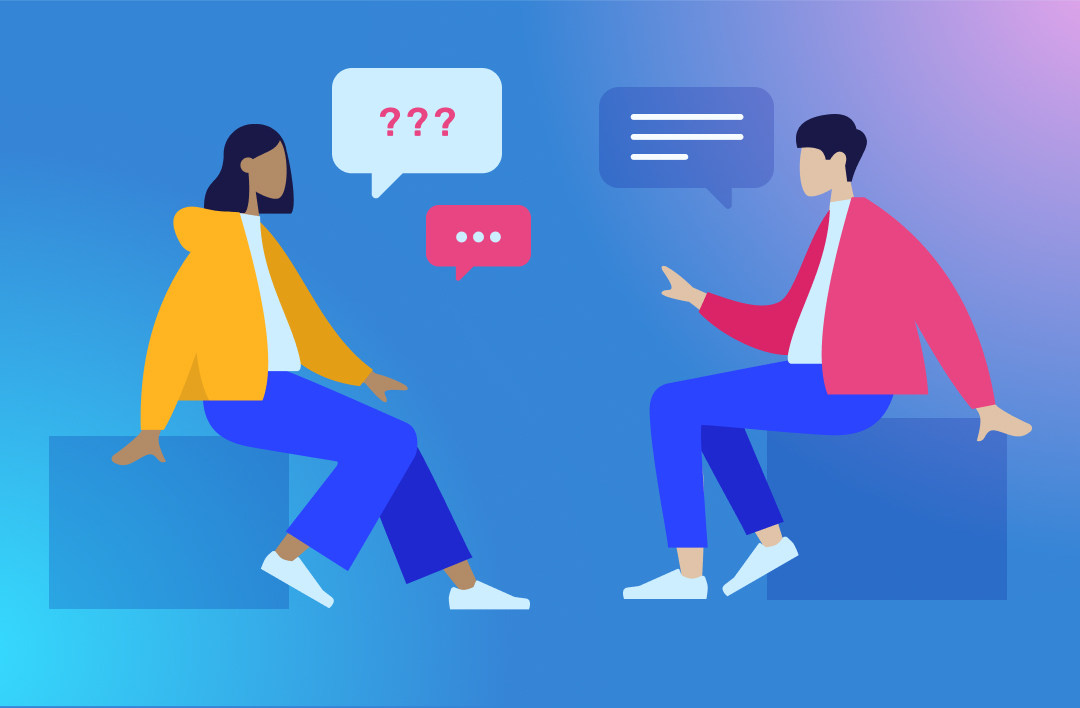How to improve user interviews

A user interview is a UX research method that can be used to gather insights into what people think and feel about a website, product or process. We run interviews at the beginning of projects, before we have designed anything. This helps us to define personas, user journeys, features and flows.
When done correctly, interviews can uncover user problems and needs that steer us in the direction of the right solution. Plenty of things can go wrong with interviews though and this can lead us in the wrong direction. Here are some tips on how to run successful interviews, whilst avoiding the pitfalls.
Prepare
Decide on what the goals of the interview will be. Prepare questions, but also anticipate the different responses you might receive. This allows you to think about follow up questions that align with your research goals.
To ensure that you’ll be able to capture everything, get the user’s permission to record the session. Alternatively, have a designated note-taker attend the session, allowing you as facilitator to focus on interviewing.
Ensure the participant is comfortable
Try to have a quick chat with the participant before the actual interview, to run through the reason for the interview and the format of it. This also allows you to introduce yourself, so when the interview takes place, you’ll have had the chance to create some rapport and build up trust.
To start the interview, it’s good to thank the participant for their involvement and let them know that it will be valuable and will contribute to the success of the project. A quick run through of what will happen during the session and how long it will last is also useful. Reassure the user that there are no right or wrong answers and that you’re there to collect research. They are not being tested in any way.
During the interview, don’t rush the participant. After they’ve said something, wait a few seconds before responding. This lets them think and gives them a chance to elaborate. Silence may seem awkward, but it’s actually very powerful. If you want to, you can use small verbal cues like “Ok” to let them know you’re listening.
Ask open questions
Ask questions where the answer would not be simply “Yes” or “No”. Yes/No answers are not particularly useful to UX researchers and they can sometimes make the participant feel like they are being interrogated! These questions start with “Did you…”, “Have you…”, “Do you…” or similar. You should try to avoid them.
Instead ask open questions, that look like this:
- "Tell me about..."
- "What do you..."
- "How do you..."
- "How often do you..."
These types of questions are a good way to avoid bias influencing users. They give participants the chance to answer on their own terms and describe their thought process.
If you are trying to understand how users approach a task or activity, the same style of questioning is helpful:
- "Can you describe.."
- "Can you tell me the steps you take to [do the task].."
- "What are the things you need in order to [do the task].."
Open ended questions can prompt longer conversations. This allows you to understand the context behind a problem and gain more of a qualitative insight into it.
Recalling past events
When asking about how the person has done something in the past, it's worth remembering that people's memories are often inaccurate. It's better to ask about a specific, recent event.
So instead of asking:
"How do you usually do [the task]...", ask
"Tell me about the last time you did [the task]..."
Also, it’s better to ask about a specific past event than asking how the person might do something in the future.
Actively listen
Give participants your full attention. Remove any distractions from the room. It’s better if you’re not sitting behind a laptop. Ideally, a pen and notebook are all you should have in front of you.
Don’t interrupt them. As mentioned above, wait a few seconds for them to pause before asking any follow up questions.
Indicate to them that you are listening, look at them, nod etc.
Ask good follow up questions. Having a goal and a plan for the interview goes without saying, but you should not just stick to your script. If you're actively listening, you should be ready to ask a good follow up question that refers to something they have said.
Actively listening to the participant will build confidence and trust during the interview and will encourage them to open up and provide you with honest insights.
Keep your reactions neutral
This helps to reduce the chance of social desirability bias influencing the participant. This type of bias occurs when participants give an answer that they think the interviewer will want to hear.
A strong reaction to something a user says, whether it's a positive or negative reaction, can influence what they say or do for the rest of the interview.
It’s important though to maintain a balance between being welcoming and showing understanding and empathy to the user, and keeping a neutral demeanour while they speak.
After the interview
When the interview ends, thank the participant for their help and ask them if they have any questions. A quick chat at the end can sometimes lead to further insights that might not have occurred during the interview.
Conclusion
User interviews are a very effective and low cost way to get a sense of how people feel about a specific product, process or idea. The value you gather from the insights depends a lot on how well the interview was planned and facilitated, so hopefully the above tips will help.
Are you planning a website redevelopment? Get in touch to discuss your options.
/sitefinity-marketing-excellence-award-2025.webp?sfvrsn=bee2b162_1)
/azure-tips-to-help-your-seo-performance.webp?sfvrsn=cb2f7cc2_2)
/why-gtm-rocks.webp?sfvrsn=98fca90d_2)